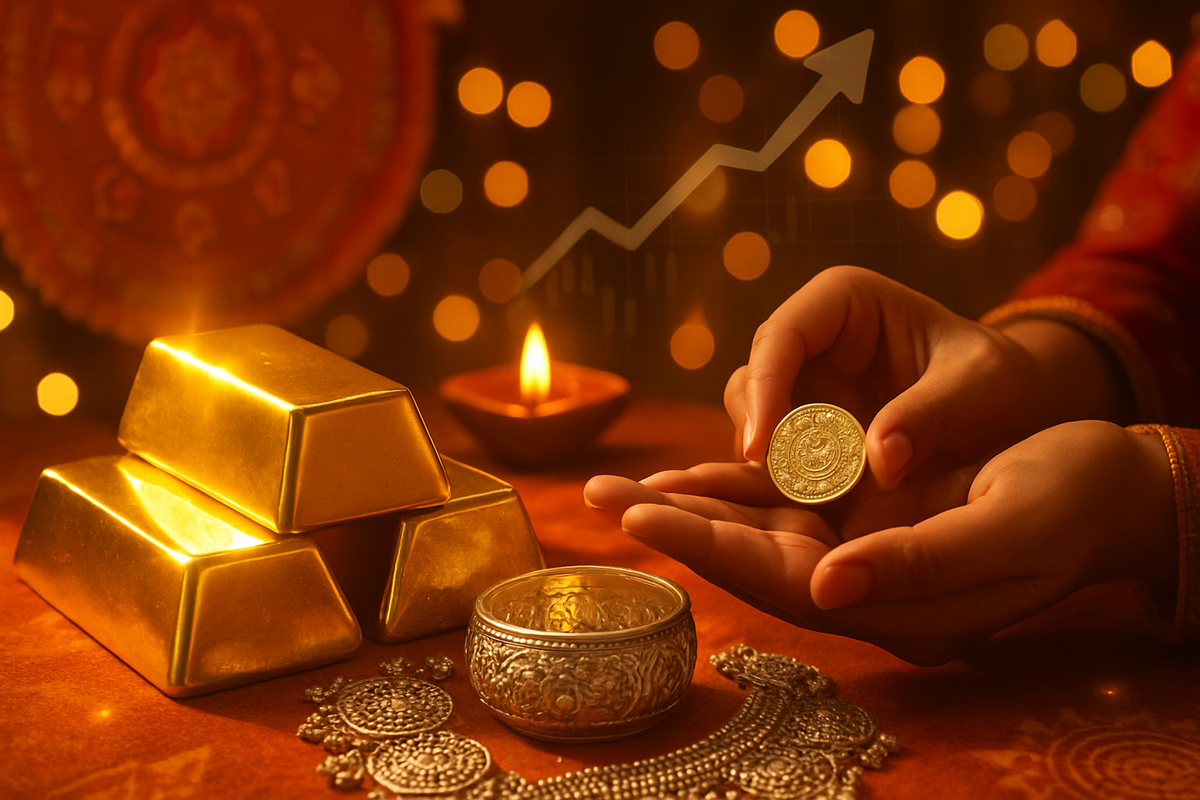
As India gears up for the auspicious Dhanteras and Diwali festivities in 2025, the financial markets are witnessing an unprecedented surge in precious metal prices. Gold has not only surpassed but firmly entrenched itself above the Rs 1.3 lakh mark for 10 grams of 24K, while silver has emphatically breached the Rs 2 lakh per kilogram threshold in many key markets. This historic rally, unfolding just weeks before one of the most significant gold-buying festivals, is sending ripples through consumer sentiment and industry strategies, compelling buyers to rethink traditional purchasing patterns and jewelers to adapt their offerings amidst a landscape of record valuations.
The immediate implications are profound for millions of Indian households and the robust jewelry sector. For prospective buyers, the dream of acquiring customary amounts of gold and silver for Dhanteras is now met with a stark reality of significantly higher costs, prompting a shift towards lighter jewelry, smaller investment units, or even alternative auspicious purchases. Simultaneously, the industry grapples with managing inventory, supply chain pressures, and catering to an evolving consumer base that is increasingly viewing precious metals through an investment lens, even as cultural traditions continue to exert a powerful pull.
Unprecedented Peaks: Decoding the Precious Metal Phenomenon
The current date of October 17, 2025, finds the Indian precious metals market in an extraordinary state. 24-carat gold is trading consistently above ₹1,32,770 and ₹1,33,770 per 10 grams across major Indian cities, with some regions like Chennai, Bangalore, Hyderabad, and Mumbai already reporting prices at the higher end of this spectrum. Silver's ascent has been even more dramatic, with prices ranging from ₹1,85,000 to ₹1,88,900 per kilogram nationally, and notably exceeding the Rs 2 lakh/kg mark in Chennai and other parts of South and Western India, driven by acute scarcity and high premiums in physical markets like Mumbai's Zaveri Bazaar.
This monumental price surge is not an isolated event but the culmination of a confluence of powerful global and domestic factors. Persistent global uncertainties, including ongoing US-China trade disputes, escalating Middle East conflicts, and concerns over potential US government shutdowns, have consistently driven investors towards safe-haven assets. A weakening US dollar and the anticipation of interest rate cuts by the US Federal Reserve have further fueled this upward momentum. Robust investment demand from central banks, which are increasing their gold reserves, and individual investors seeking a hedge against inflation and economic instability, have provided a strong foundation for the rally. For silver, an additional critical driver is the burgeoning industrial demand from rapidly expanding sectors such as solar energy, electric vehicles (EVs), and 5G technology, creating a significant supply deficit. Domestically, the deeply ingrained cultural significance of buying gold and silver during Dhanteras and Diwali traditionally ignites demand, which is now interacting with these already elevated global prices, further exacerbated by a severe physical shortage of silver in both Indian and international markets.
Key players navigating this environment include millions of individual buyers, from those making customary festive purchases to long-term investors. Jewelers, ranging from large organized retailers to local artisans, are at the forefront of adapting to these market dynamics. Central banks globally, through their gold acquisition strategies, and commodity traders and investors, are also significant stakeholders influencing and reacting to these price movements. Initial market reactions reflect a mixed sentiment: while there's an element of "Fear of Missing Out" (FOMO) among some buyers anticipating further price hikes, others, particularly lower and middle-income families, face disappointment and the necessity to adjust their festive budgets. The jewelry industry is responding by diversifying product offerings, focusing on lighter, intricately designed pieces and studded jewelry, while simultaneously grappling with the challenges of securing physical inventory, especially for silver, where some major jewelers have reportedly stopped taking fresh orders for the festive season due to acute scarcity.
Corporate Fortunes Amidst Golden Tides: Winners and Losers
The unprecedented rally in gold and silver prices presents a complex scenario for public companies, creating both significant opportunities and considerable challenges across various sectors.
Jewelry retailers, particularly the larger, organized players like Titan Company Limited (NSE: TITAN) and Rajesh Exports Ltd. (NSE: RAJESHEXPO), find themselves in a unique position. While the sheer increase in value per gram means higher revenue figures, the volume of sales might see some moderation as consumers opt for lighter items or defer purchases. These companies are likely to benefit from the increased value of their existing gold and silver inventory, leading to higher inventory valuations. Their strategic shift towards promoting lightweight designs, studded jewelry, and higher-margin items like diamonds, rather than pure gold weight, could help maintain profitability. However, managing customer expectations and adapting to potential shifts in purchasing power among different income segments will be crucial. The acute shortage and high premiums on physical silver could pose significant operational challenges for retailers heavily reliant on silver products, potentially impacting their margins and inventory turnover.
Conversely, companies involved in gold mining and silver production, though less prominent in the Indian public market, would typically see a direct benefit from higher commodity prices, assuming stable production costs. Globally, major gold mining companies like Newmont Corporation (NYSE: NEM) or silver producers could report stronger earnings. For Indian companies dealing in bullion trading and refining, the increased price volatility and volume, particularly driven by investment demand, could translate into higher trading revenues, though they also face increased capital requirements for inventory. Financial institutions offering Gold Exchange Traded Funds (ETFs) or Sovereign Gold Bonds (SGBs) could also see increased interest from investors looking for non-physical avenues to participate in the gold rally, potentially boosting their asset under management (AUM).
However, the rapid price appreciation also introduces risks. For jewelers, a sudden correction post-festive season could lead to inventory devaluation, impacting profitability. The shift in consumer preference towards lighter items or non-physical gold might also necessitate significant marketing and product development investments. For consumers, the high entry point for investment in physical gold and silver, coupled with potential for short-term volatility, means that careful consideration of investment strategies and risk management is paramount. The overall economic impact could also be felt by consumers who allocate a significant portion of their festive budget to precious metals, potentially reducing discretionary spending in other sectors if gold and silver purchases consume a larger share of their income.
Broader Implications: A Shifting Economic Landscape
The current surge in gold and silver prices before Dhanteras 2025 is more than just a seasonal anomaly; it signifies deeper shifts within global and domestic economic landscapes. This event fits squarely into a broader trend of increased investor flight to safe-haven assets, fueled by persistent geopolitical instability, inflationary pressures, and a general sense of economic uncertainty. The weakening US dollar and the dovish stance anticipated from the US Federal Reserve regarding interest rates are key macroeconomic drivers, making non-yielding assets like gold more attractive by reducing the opportunity cost of holding them.
The ripple effects of this phenomenon are extensive. Competitors within the jewelry sector, particularly smaller, unorganized players, may struggle to match the inventory and pricing flexibility of larger retailers, potentially leading to market consolidation. Partners in the supply chain, from refiners to logistics providers, face increased demand and the challenges associated with managing higher-value inventory. The regulatory implications could also be significant. Governments might explore measures to manage demand or supply, potentially through import duties or policies aimed at encouraging alternative investment instruments to physical gold. Historically, such sharp increases in precious metal prices have often preceded periods of economic recalibration or heightened inflation, drawing parallels to previous gold rallies during times of global crises. For instance, the gold surge during the 2008 financial crisis or the early 2010s debt crises underscored its role as a hedge against systemic risk. The current situation, however, is unique due to the confluence of both investment and strong industrial demand for silver, creating a dual-pronged upward pressure.
The sustained demand for silver, driven by its critical role in green technologies like solar panels and electric vehicles, highlights a structural shift in its market dynamics. This industrial demand, unlike purely investment-driven surges, suggests a more resilient price floor for silver in the long term, making it less susceptible to sharp corrections solely based on investor sentiment. This also implies potential ripple effects on related industries, as the cost of raw materials for renewable energy and EV manufacturing increases, potentially impacting their profitability or consumer prices. The ongoing physical shortage, particularly for silver, further complicates the picture, suggesting that supply-side constraints are playing a significant role beyond mere speculative buying, potentially prompting governments and industries to explore new mining ventures or recycling initiatives.
The Road Ahead: Navigating Volatility and Opportunity
Looking ahead, the precious metals market is poised for continued dynamism, with both short-term fluctuations and long-term strategic realignments. In the short term, the festive season demand, particularly around Dhanteras and Diwali, is expected to provide continued support for current high prices. However, once the festive fervor subsides, there is a possibility of some price correction or normalization, especially if global economic uncertainties ease or if there's a significant shift in monetary policy outlook. For buyers, a staggered approach to purchasing, rather than a lump-sum investment, might be a prudent strategy to mitigate risks associated with potential post-festive volatility.
In the long term, the outlook for gold and silver remains robust, underpinned by persistent global economic uncertainties, inflation hedging, and the increasing industrial demand for silver. This environment necessitates strategic pivots for various stakeholders. Jewelers will likely continue to innovate with product offerings, focusing on design, craftsmanship, and value-added services over sheer metal weight. They may also explore stronger digital sales channels and pre-booking options to manage inventory and price risks. For investors, the event highlights the enduring role of precious metals as a portfolio diversifier. Beyond physical assets, the market opportunities in Gold ETFs and Sovereign Gold Bonds (SGBs) will likely expand, offering more accessible and secure investment avenues, particularly for those wary of physical storage and making charges.
Potential scenarios include a sustained rally if global geopolitical tensions escalate further or if central banks continue aggressive gold accumulation. Conversely, a sharp de-escalation of conflicts or a more hawkish stance from central banks could trigger a downward correction. The acute physical shortage of silver could also lead to further price spikes if industrial demand continues to outstrip supply, creating a unique challenge and opportunity for producers and consumers of industrial silver. Ultimately, the market will likely be characterized by increased volatility, requiring adaptability from both consumers and businesses.
A Golden Era of Uncertainty and Strategic Adaptation
The unprecedented surge in gold to Rs 1.3 lakh per 10 grams and silver to Rs 2 lakh per kilogram ahead of Dhanteras 2025 marks a pivotal moment in the Indian precious metals market. The key takeaway is a clear shift: while cultural significance continues to drive demand, the economics of acquisition are fundamentally changing. Buyers are becoming more discerning, prioritizing investment value, lighter designs, or exploring alternative forms of precious metal ownership. The festive season, traditionally a period of unbridled buying, is now characterized by strategic decision-making and a nuanced approach to precious metal purchases.
Moving forward, the market is expected to remain highly sensitive to global macroeconomic indicators, geopolitical developments, and the evolving dynamics of industrial demand for silver. For jewelers, adaptability and innovation will be paramount, requiring a focus on product diversification, efficient inventory management, and a keen understanding of shifting consumer preferences. Investors should continue to watch for central bank policies, inflation trends, and the trajectory of global economic growth, which will largely dictate the sustained momentum of this rally. The enduring appeal of gold and silver as stores of value, coupled with silver's growing industrial utility, suggests that these metals will continue to play a significant role in investment portfolios and cultural traditions, albeit within a new paradigm of elevated prices and strategic considerations.
This content is intended for informational purposes only and is not financial advice





